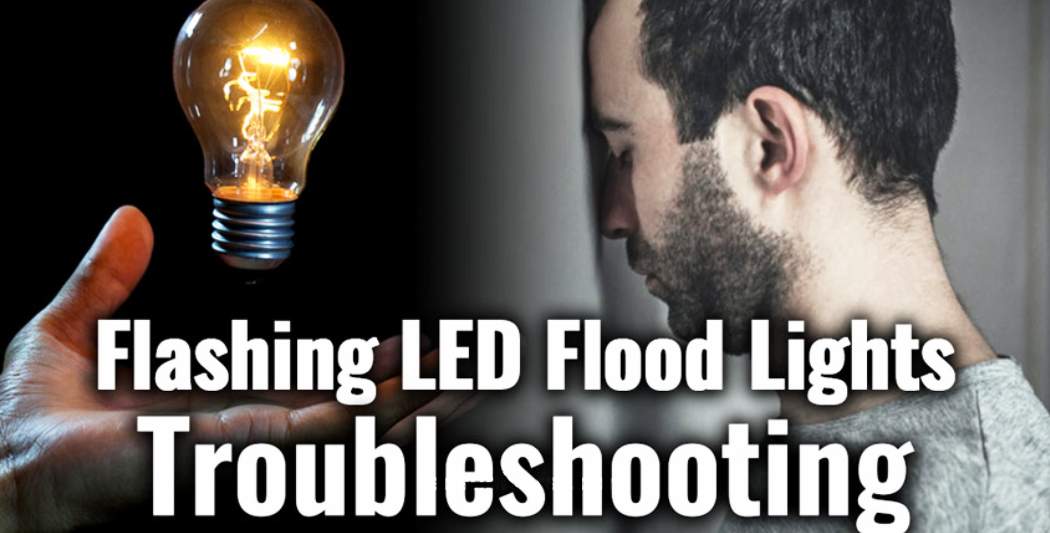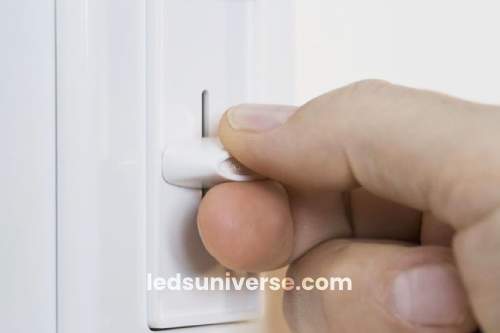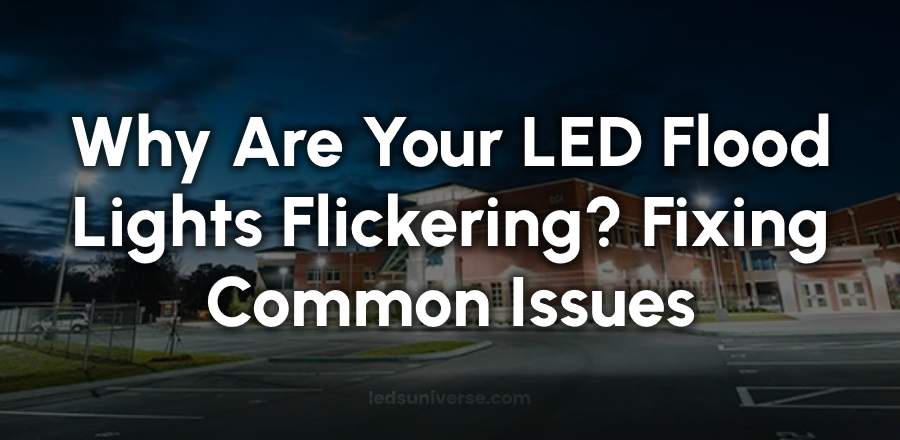A frequent issue encountered with LED flood lighting is flickering, which can manifest as rapid flashing on and off. This persistent annoyance can disrupt the intended purpose of these lights, which are designed to illuminate expansive areas effectively. The erratic behavior of floodlights can stem from a variety of factors, making it challenging to pinpoint the underlying cause. Among these factors, a malfunction in the driver circuit that regulates the electrical current supply may be a leading cause. However, a wide range of reasons, from common issues to more unique situations, could lead to such flickering.
When discussing LED floodlights, references to 12V and 24V options are commonplace. It is important to recognize that most LED lights operate as 3V DC devices. To achieve the required voltage for LED floodlights, manufacturers configure the LEDs in both parallel and series combinations. A notable difference between 12V and 24V configurations is the cut-line interval. For 12V systems, the distance is typically 1 inch, whereas, for 24V systems, it spans 2 inches. This configuration grants greater flexibility for 12V systems when cutting the strips to a desired length. Conversely, 24V configurations tend to offer enhanced efficiency due to a reduced potential for voltage drop, thus minimizing flickering.
Understanding the application of the floodlights is another factor when deciding between 12V and 24V options. If the objective is to illuminate a nearby area, 12V bulbs are preferable, as they operate at lower voltage, directing more light to the immediate vicinity rather than projecting it over a broader area. In contrast, higher voltage systems are necessary for applications requiring illumination over greater distances.

Table of Contents
ToggleReasons for LED Floodlight Flickering
Occasional flickering of LED floodlights is a normal occurrence and can be attributed to various simple factors. However, it is beneficial to determine whether the flickering is sporadic or consistent. A recent change in the flickering pattern may indicate an underlying issue within the lighting system or the electrical circuit. If the flickering is a new development, further investigation is warranted to identify and address the root cause.
Dimmer Switches
Dimmer switches are often the primary culprits behind flickering LED floodlights. Traditionally, dimmers were designed for use with incandescent and CFL bulbs, which operate at higher voltage levels. When these older dimmers are applied to low-voltage LED systems, compatibility issues arise, leading to flickering. Fortunately, modern dimmer switches and LED bulbs are engineered to work together effectively, eliminating many of these issues.
To mitigate flickering, it is advisable to ensure that both the dimmer switches and LED bulbs are of a newer variety and are compatible with each other. If flickering persists, checking the driver circuit is a prudent first step.
Circuit Design and Supply Capacity
Another common factor contributing to flickering is outdated electrical circuits. Many existing circuits were designed decades ago when fewer electrical appliances were in use. As the demand for electricity has increased with the addition of various devices, these older circuits may struggle to accommodate the load, resulting in underperformance or inefficiencies.
If flickering occurs when larger appliances are activated, such as air conditioners or washing machines, the circuit may be overloaded. Each electrical circuit has a specific capacity for power supply, and exceeding this capacity can result in voltage drops, leading to flickering or dimming of lights. While brief flickering during appliance startup may be typical, persistent issues should prompt further investigation from a qualified electrician to assess the circuit’s ability to meet current demands.=
Loose and Faulty Wiring
Consistent flickering of LED floodlights can also indicate loose wiring or outdated components, including fixtures, switches, and connectors. These problems may stem from poor-quality wiring or systemic issues within the electrical setup. In addition to flickering, compromised wiring can lead to poor performance of other electrical devices and pose serious safety hazards. Faulty wiring is a leading cause of fires in both residential and commercial settings.
Loose connections can create arcing, where electricity jumps across gaps, potentially igniting fires. This heightened resistance can also lead to overheating, putting the entire establishment at risk. Potential trouble spots include faulty switches, aging fixture wiring, worn connectors, and service conductors in the electrical panel. If flickering increases without any recent changes to the electrical setup, it may be wise to investigate the condition of the wiring and connections.
Voltage Fluctuations
Voltage fluctuations within the fixture’s wiring frequently contribute to flickering. Such fluctuations can affect the current reaching LED floodlights, causing erratic behavior. Observing how the lights react when other electrical appliances are in use can help identify whether voltage fluctuations are the cause of the issue. If flickering aligns with the operation of large appliances, it is likely due to voltage fluctuations in the electrical circuit.
Fluctuations can occur in circuits with multiple low-voltage LED bulbs connected in various configurations. Sudden dimming or flickering when large appliances are turned on, or persistent flickering when such appliances are not in use, often indicates voltage instability. Normal voltage fluctuation should fall within the range of 115 to 125 volts, with significant issues arising if the levels exceed 125 volts. A voltmeter can assist in monitoring voltage fluctuations to identify potential issues.
Neighbors’ Electricity Consumption
The electricity supply in a household is often linked to a shared transmitter with nearby residences. If neighboring households consume more electricity collectively, this can impact the voltage received at your location. High electricity demand from neighbors, especially when using power-intensive appliances, may lead to voltage drops that result in flickering LED floodlights.
To determine if this is the case, observing patterns in flickering during peak usage times within the neighborhood may yield insights. If similar flickering occurs across other homes in the vicinity, the utility service may be experiencing challenges, and reporting these issues to the service provider may be necessary
Entire House Facing Issues
When flickering is observed not just in LED floodlights but throughout the entire household, the source of the problem may lie within the meter box. This situation necessitates an examination by a qualified electrician, as it could indicate broader issues with the electrical system. In contrast, if the flickering is isolated to the floodlights, it may suggest a localized issue with those specific lights.
If voltage fluctuations impact the overall electrical system, the integrity of other devices and appliances may also be at risk. Monitoring the performance of various appliances can provide clues to the source of the problem
Troubleshooting LED Floodlight Flickering
When troubleshooting flickering LED floodlights, a systematic approach can help identify the root cause. Here are some methods to investigate potential issues:
| Inspection Step | Summary |
|---|---|
| Inspect Dimmer Switches | Check if dimmer switches are compatible with LED bulbs; consider upgrading to newer dimmers to resolve flickering. |
| Evaluate Circuit Capacity | Assess the age and design of the electrical circuit; consult an electrician to determine if upgrades are needed. |
| Check Wiring and Connections | Perform a visual inspection of wiring and connections to identify loose or damaged components that may cause flickering. |
| Monitor Voltage Levels | Use a voltmeter to check for voltage fluctuations; investigate if measurements are outside the normal range. |
| Consult Utility Provider | Contact the utility service if flickering aligns with neighbor activities to identify potential broader power supply issues. |
| Engage a Qualified Electrician | If issues persist after troubleshooting, seek help from a qualified electrician for expert diagnosis and solutions. |
Maintaining Optimal LED Floodlight Performance
Ensuring LED floodlights function optimally requires regular maintenance and attention to several factors. Following best practices can prolong the life of these lights and maintain consistent performance:
Regular Inspections
Routine inspections of floodlight fixtures, wiring, and connections can help identify potential issues before they escalate. Look for signs of wear, damage, or loose connections. Keeping the area around floodlights clear of debris and ensuring that they are clean can also enhance performance.
Upgrading Components
As technology advances, older components such as dimmer switches may become outdated. Upgrading to modern, compatible components can improve compatibility with LED technology and reduce flickering.
Voltage Regulation
If voltage fluctuations are a recurring issue, consider installing voltage regulation devices to stabilize the electrical supply. These devices can help mitigate fluctuations that may impact LED floodlight performance.
Professional Maintenance
Engaging a qualified electrician for periodic maintenance can ensure that the electrical system operates efficiently and safely. Their expertise can help identify issues that may not be immediately apparent and provide solutions tailored to specific needs.
Conclusion
The flickering of LED floodlights can arise from various factors, ranging from simple component incompatibilities to more complex electrical system issues. Regular maintenance, careful monitoring of electrical performance, and timely upgrades to modern components can greatly enhance the reliability and effectiveness of LED floodlights. Addressing flickering promptly can prevent potential hazards and ensure that outdoor spaces remain well-lit and safe.
